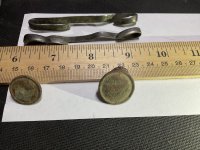KiddoTheMiner
Sr. Member
- Jun 9, 2014
- 391
- 169
- Detector(s) used
-
Jobe drop riffle sluice
Garrett gold pan
- Primary Interest:
- Prospecting
so in my time prospecting(not long)
ive been trying for a goal of 2.5 grams a day
today I made it out for 3 hours and probably dug a hole 1.5 yards in size with some good gold retention in my
homemade fluid trap
so if in 8 hours I can move maybe 4.5 yards of material 2.5 grams of gold is $100/4.5 yards
I need around $22, which I have had no success finding, ive spent entire days sampling gravel bars or working material
and I haven't even got a gram in my season count, so I have to be doing something wrong
ive already come to the assumption that the general area im working doesn't have much gold and I need to move
so I guess im asking what kind of gold do I need per pan or per bucket to reach my goal
also is $22 a yard common or rare in Georgia, do I have unrealistic expectations or is $22 a minimum
any help is appreciated, heavy pans


ive been trying for a goal of 2.5 grams a day
today I made it out for 3 hours and probably dug a hole 1.5 yards in size with some good gold retention in my
homemade fluid trap
so if in 8 hours I can move maybe 4.5 yards of material 2.5 grams of gold is $100/4.5 yards
I need around $22, which I have had no success finding, ive spent entire days sampling gravel bars or working material
and I haven't even got a gram in my season count, so I have to be doing something wrong
ive already come to the assumption that the general area im working doesn't have much gold and I need to move
so I guess im asking what kind of gold do I need per pan or per bucket to reach my goal
also is $22 a yard common or rare in Georgia, do I have unrealistic expectations or is $22 a minimum
any help is appreciated, heavy pans



Upvote
0





